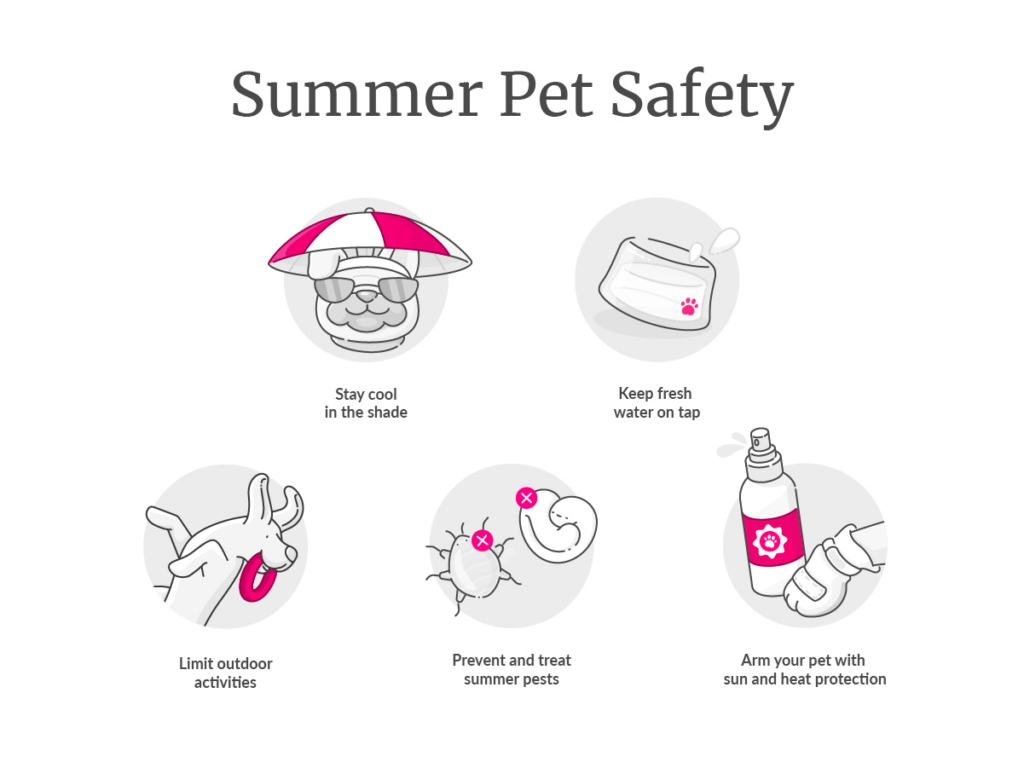Heat Stroke in Dogs
As temperatures rise, so does your pup's risk of overheating to life-threatening levels.

As temperatures rise, so does your pup's risk of overheating to life-threatening levels.

As the US and beyond face brutal heat waves, the risk of heat stroke in dogs also spikes. Heat stroke can be a life-threatening condition for dogs, so it’s important to take preventative measures, understand the early signs, and have a plan in place to get your pup the care they need right away.
Read on to learn more about how you can help keep your dog happy and healthy in the summer heat.
The American Animal Hospital Association warns that if the core temperature of your pet gets higher than the normal range (100 – 102.2 degrees) they have heat stroke—aka hyperthermia.
Our pets don’t sweat like we do, making them overheat more easily—and with more dangerous consequences.
Heat stroke can impact the ability of your pup’s bodily systems—like clotting, digestion, and oxygen and heat exchange—to function normally. And in severe cases it can lead to organ failure, or sudden death, or the need to euthanize your pet.
While any pet can be at risk for heat stroke, dogs are much more prone to it than cats, since felines usually hang out indoors, or in the shade.
There are several clinical signs of heatstroke to look out for, such as:
Consulting with vet or a professional at a veterinary hospital can help you accurately diagnose your pet’s condition.

There are lots of factors that can lead to heat stroke in dogs, including:
According to the American Veterinary Medical Association, one of the leading causes of heat stroke in dogs is leaving them in the car. (And leaving the window cracked doesn’t really make a difference.)
A 2020 study in the UK found that exercise can be just as dangerous of a trigger as a hot car.

We asked our favorite veterinarian, Dr. Stephanie Liff, for her top tips to help your dog beat the summer heat and prevent heat-induced illness, like heat stroke. Here’s what she recommends:
If you see signs of your pet having heat stroke, get them to the emergency vet ASAP.
Heat stroke progresses rapidly, and first aid measures at home are not a substitute for veterinary care.
It might feel like a no-brainer to help your pup cool down at home, but you’d be overlooking other complications associated with heat stroke such as organ damage, dehydration, and electrolyte imbalance, and you’d risk sending your dog into shock.

Once you get your pup to the veterinary clinic or animal hospital, your dog’s body temperature will be closely monitored while they are cooled down.
Once stabilized, further treatment will depend on the clinical signs and the severity of the heat stroke. Your dog might require things like:
The average cost to treat heat stroke in dogs in 2024 is roughly $500 to $1,000.
More severe cases that require a multi-day hospital stay in the ICU could come with a price tag of $5,000 to $15,000 or more.
Yes, pet insurance plans often cover treatment for heat stroke, but the extent of the coverage will depend on your specific policy.
For example, a basic Lemonade pet insurance policy could help cover the costs of your dog’s heat stroke treatment, minus your deductible and co-insurance.
If your dog experiences heat stroke once, make sure to closely follow the advice of your vet to prevent your dog from having heat stroke again in the future. If you don’t take the extra precautions that were recommended by your vet and your dog has heat stroke again, their treatment might not be covered by your pet insurance.
Let’s say your pup gets heat stroke after joining you for a Fourth of July 4K fun run in 100 degree weather. Your four-legged running buddy makes a full recovery, but your vet explains the dangers of running extended periods of time in the heat with your pup. Then on Labor Day your pooch joins you for a 5K race when it’s 98 degrees outside and gets heat stroke again. This time around your pet insurance might deny a claim related to the incident.
Yes, dogs can overheat quickly in parked cars, even with the windows open. It’s one of the leading causes of heat strokes in dogs. Learn more about dog car safety measures here.
Yes, obesity is one of the risk factors for heat stroke. Overweight dogs may have extra layers of fat that insulate their bodies and prevent them from cooling down effectively.
They might also overexert themselves during exercise or play, causing their body temperature to rise more quickly, making it crucial to maintain a healthy weight for your pet, particularly during the hot summer months.
Yes, older dogs are at a higher risk. As dogs age, their ability to regulate body temperature can decrease, and they may have other health conditions that make them more susceptible to heat.
They also may not be as capable of moving to a cooler area if they get overheated, so it’s especially important to take extra precautions to prevent heat-related illnesses in senior dogs.
A few quick words, because we <3 our lawyers: This post is general in nature, and any statement in it doesn’t alter the terms, conditions, exclusions, or limitations of policies issued by Lemonade, which differ according to your state of residence. You’re encouraged to discuss your specific circumstances with your own professional advisors. The purpose of this post is merely to provide you with info and insights you can use to make such discussions more productive! Naturally, all comments by, or references to, third parties represent their own views, and Lemonade assumes no responsibility for them. Coverage and discounts may not be available in all states.
Please note: Lemonade articles and other editorial content are meant for educational purposes only, and should not be relied upon instead of professional legal, insurance or financial advice. The content of these educational articles does not alter the terms, conditions, exclusions, or limitations of policies issued by Lemonade, which differ according to your state of residence. While we regularly review previously published content to ensure it is accurate and up-to-date, there may be instances in which legal conditions or policy details have changed since publication. Any hypothetical examples used in Lemonade editorial content are purely expositional. Hypothetical examples do not alter or bind Lemonade to any application of your insurance policy to the particular facts and circumstances of any actual claim.